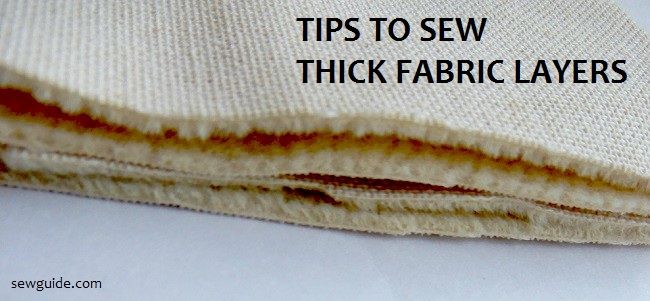
Those thick layers of fabric and multiple frustrated sighs – they have some connection. Especially when you have an urgent project and your simple home sewing machine refuses to go through the layers of thick fabric you are feeding through it. I am talking about sewing with layers of upholstery fabrics, denim, vinyl, leather, quilted fabrics, synthetic suede, fake fur etc.
Seam allowances of thick fabrics are bulky and people usually struggle to stitch over many layers of thick fabrics neatly with home sewing machines. And inevitably some seams will cross and that is when the nightmare really begins. There may be skipped stitches, thread snapping, needle breaking etc. and many many swear words.
Related posts: What to do for skipped stitches?; What to do if needle breaks often?.
Home sewing machines are usually meant for medium weight fabrics, that too not too many layers – 3, 4 maximum. They start developing all those frustrating (inevitable, considering their delicate bodies) problems that they are prone to, a little prematurely.
Acknowledge that these delicate machines are meant for simple work but there are some simple tricks you can follow to conquer these hiccups
How to Sew through thick layers of fabric with ordinary sewing machine.
Choose projects carefully
This goes without saying when sewing with thick fabrics. Choose to make simple dresses without too many pattern pieces, darts, or small pieces such as collars and welt pockets so that you do not need to sew that much more. Other things to avoid are any extra seams, tucks, shoulderpads and unnecessary buttonholes.
Test the right stitch combination for buttonholes on a scrap fabric before trying on the garment. On thick fabrics some stitches may not look the same as on other fabrics. If you are adding lining, you can attach the lining to the garment with hand sewn french tacks rather than actual machine sewing.
Check this about your sewing machine
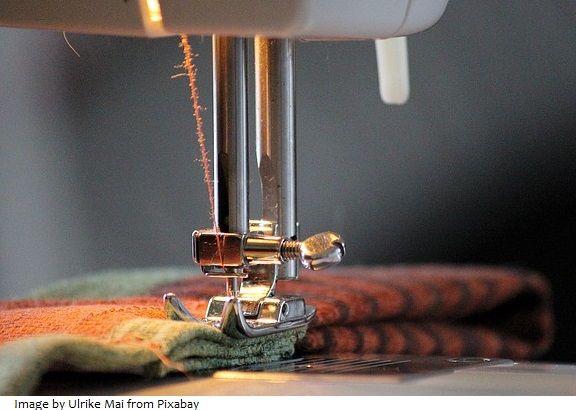
Is your sewing machine capable of taking in those layers. Are you trying the impossible? Ensure that the layers will go under the machine’s pressure foot. Before sewing, it should sit under the presser foot. You can raise the presser foot lever to get the presser foot to its highest position. If that does not solve the problem, try the next two tricks to make your fabric behave and adjust.
Use some steam on the fabric
Steam can soften fabrics and they will be more malleable when wet. You can use the steam from your iron for this. Hover the iron some distance from the fabric and allow the steam to permeate the fabric.
Use a Hammer /rubber mallet or a tailor’s clapper
If you have stubbornly thick areas, like where seams cross each other, some whacks from a small hammer can make them behave. This can really help when sewing those thick jeans hems.
You can also use a Tailor’s clapper, if you have it – it is a tool made of wood with rounded edges – you press down the thick seams with this tool after you have applied the steam and this makes the seam magically flat. Very useful for quilters who have to deal with multiple seams at once.
Do not forget to place another cloth between the hammer and the fabric you are sewing, to prevent damage.
No Pins! Instead use clips
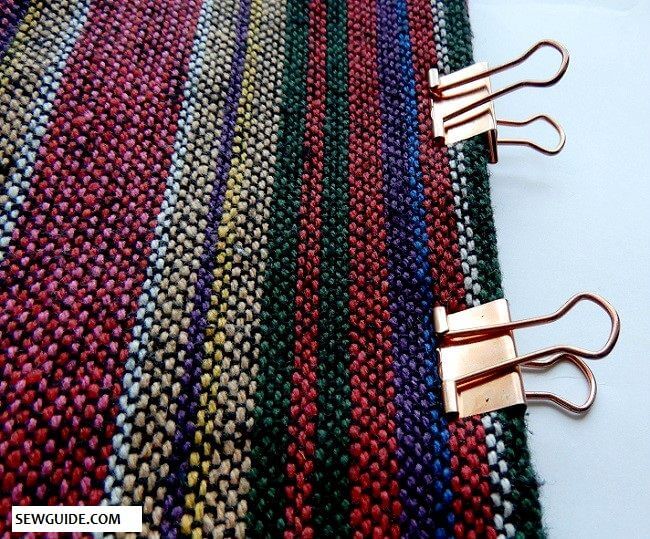
If the layers of fabrics are too thick to be pinned, use paper clips, binder clips and even clothespins to keep the fabrics together. Do not forget to remove them as you sew.
Choose Proper interfacing
Even with thick fabrics, sometimes you may want a crispiness which interfacing can provide. In this case, choose a lightweight fusible interfacing or use silk organza or cotton batiste as a sew-in interfacing that can give that crispiness without making the fabric more heavy and impossible to sew.
Cut the fabrics on the same grain as the outer fabrics.
Use a heavy duty needle and suitable thread
A heavy-duty needle starting with No. 90/14 (or a jeans needle which is usually No. 16 or even the largest size universal needle you get) may be needed for sewing through heavy-weight fabrics.
You can use a thicker thread like a jeans thread or strong polyester thread. You should know that lower the size mentioned on the thread the thicker the thread. A 30 -50 size thread is used for sewing thick fabrics.
Use a longer stitch length or change stitch
Use more than the standard 2.5 length for the straight stitch for the seam – best is a 3.5 length stitch. But this depends on the fabric. For thick fabrics like denim and canvas you can sew with a stitch length of 3 (adjust from 2.6). For even thicker fabrics (faux leather, cork, leather) use 3.5.
If this doesnot work try a small zig zag stitch.
Clip and trim
Seam finishes are not easy to do with thick fabrics. When you want to finish the seam allowance neatly, clip and trim generously. Here is an easy way to do it.
To perfectly finish the seam of thick fabrics – After sewing a regular seam, trim one of the seam allowance to 1/4 inch. Press the longer seam allowance to cover the trimmed seam allowance. Now top stitch from the outside; ensure that you have caught the seam allowance which is pressed on the back.
When seams cross, ie you have to sew more than one seams together, remember to trim the seam allowances diagonally to avoid the bulk.
Use a walking foot
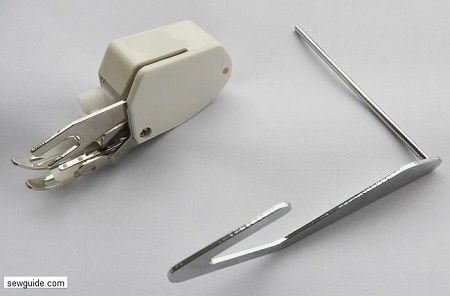
A walking foot will go through thicker layers easier than a regular foot. This is regularly used in making quilting stitches ( and that is bulky) so it works.
You can learn more about using a walking foot here.
Use the hand wheel
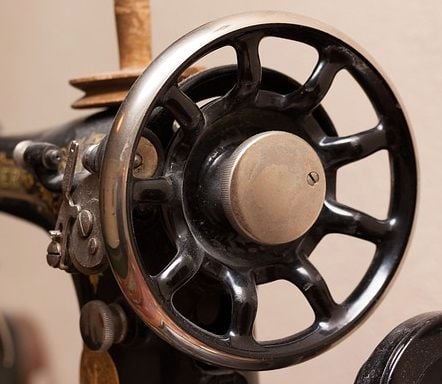
When you reach thick layers you can stop the electric motion and turn the hand wheel to move the machine (you are in control and the needle is not taxed)
Hand sew
If the machine is still refusing to behave and you have only a manageable area to sew, you can hand stitch with a thick hand sewing needle and heavy-duty (jeans) thread.
If there are many layers it is a good idea to baste stitch (by hand sewing). More complicated it is or more layers there are, the better it is to make enough and plenty of basting stitches.
Thick fabrics can be hemmed with a loose catch stitch- this will give it a small stretch and you can sew it easily as well. Learn more about this stitch in this post on invisible stitches.
Related posts : Easy hand sewing stitches ; How to sew by hand.
Use clever sewing techniques
Hemming thick fabrics may prove tricky and you may not want the bulky look of turned hems. You can use a faced hem for thick fabrics. Use a bias strip of a medium weight fabric of the same color of about 2 -3 inches wide. Sew as you would a binding. You can hand sew the binding to the back for an almost invisible hem finishing.
Use a Serger
An alternative to conventional seam is to stitch the seam with a 4 thread serged stitch. But this is possible only if you have a serger. Here is a post on buying sergers.
Change your sewing machine
If after all the above tricks, you still have your layers un-stitched and you hair is on end, maybe you are already considering a change of your sewing machine. For sewing thick fabrics and layers you need more than the simple plastic sewing machine with plastic parts especially the plastic bobbin area. You need a sewing machine with front loading, metal hook and bobbin case.
You can buy an industrial sewing machine – These machines are meant to sew through multiple layers without breaking a needle or their inner parts. Or getting you into vapours of frustration like the normal mechanical ones would do.
But there is more to Industrial machines than a beginner or an intermediate sewist would want or need. You can checkout this post on Industrial sewing machines and the factors that indicate whether you need to buy one.
As I write this, Scientists are even inventing Time Machines! I am asking only for that small sewing machine which will sew thorough anything and everything. Surely some one is listening. If they are, consider a man-less one too, like the driver-less car.
Till then, you can buy a sturdy heavy duty one that claims it will sew through layers.
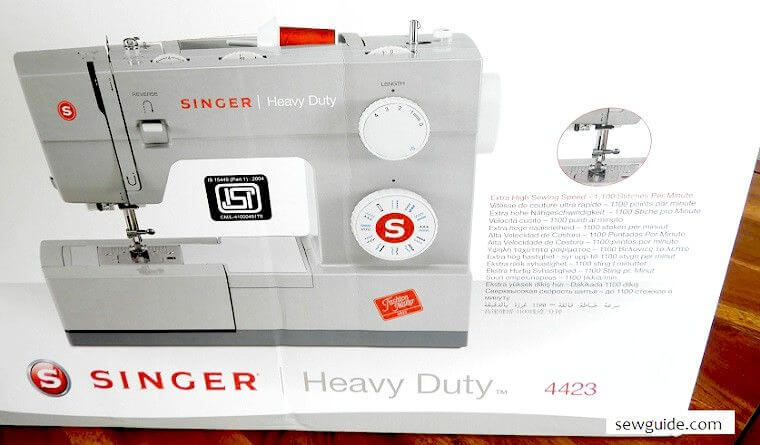

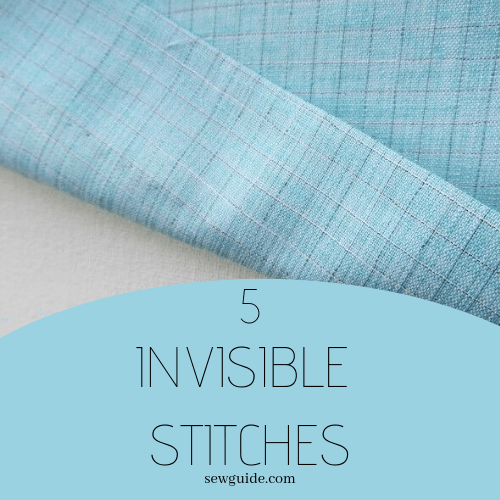
Thank you sooooooo much.
I’ll apply this in my next work
Thank you so much, I’m making protection masks and didnt have a clue. I have a new Brothers and it says nothing about pleats or thick gathers.
Exactly! I have a love hate relationship with mask pleats. I want to use rectangular patterns so the cutting isn’t so fiddly but the pleats aggravate me. Thank you.
Hi Rebecca,
In this page on masks you will get a pattern to make a mask without pleats. Hope that helps.
The shaped mask is easy to sew & doesnt cut across the bottem of your eyes like the rectangle one does. Ive made both. This is a good tutorial & has patterns: https://www.youtube.com/watch?v=KBR98YKAr7w&feature=youtu.be